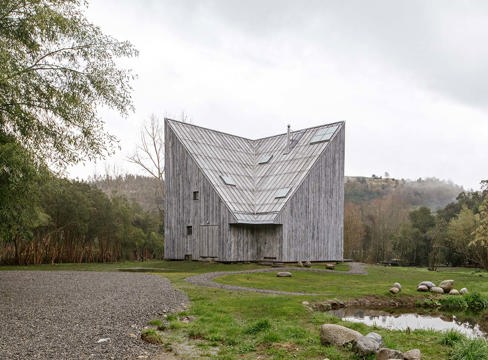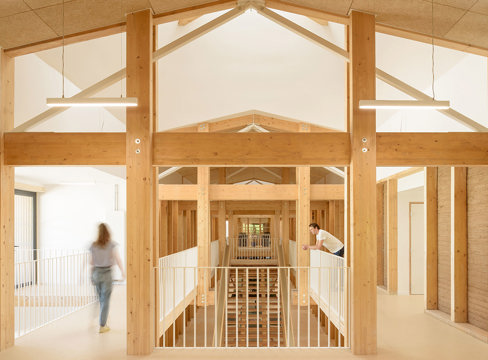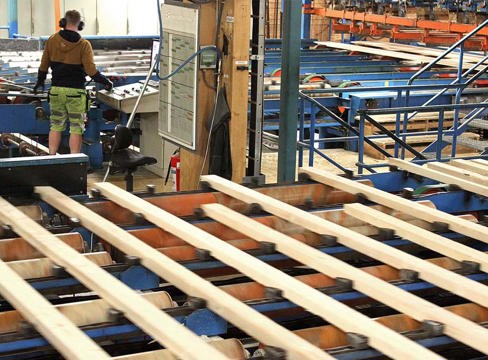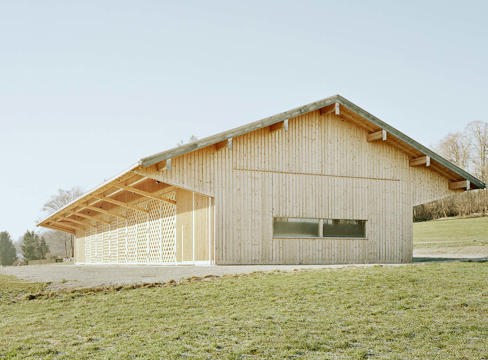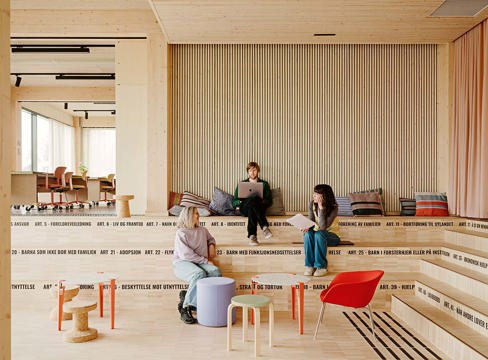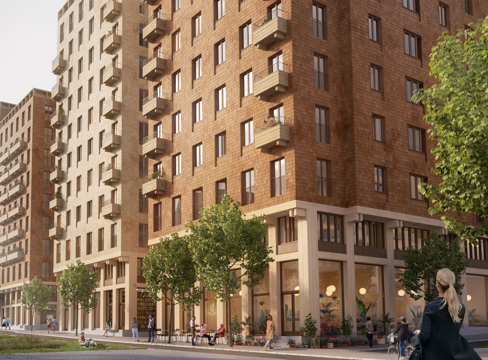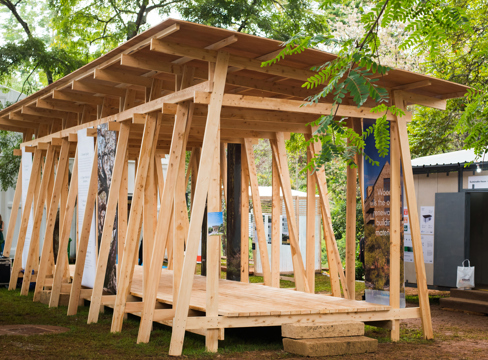Climate-smart building
Wood stores carbon dioxide
Through photosynthesis, growing trees store carbon dioxide in the form of carbon compounds. (Wood and soil also release a certain amount of carbon dioxide, but they absorb considerably more.) The faster the forest grows, the more carbon dioxide is captured. From a climate perspective, it is therefore better to manage the forest and use the wood than to leave the forest untouched. The carbon dioxide that is stored in the trees then remains in place throughout the life of the tree, even after it has been turned into a wood product. It is therefore particularly good to use wood for large and long-lasting products such as the structural frames of buildings.
The forest will not run out
For more than a century we have taken great care to look after the forests in Sweden. At least two new trees are planted for every tree harvested. The growth in our forests is thus much greater than the extraction of wood, and stocks of wood are steadily increasing. This ensures that our forests can provide a never-ending supply of construction material.
Wood has climate benefits in every phase
- Production phase
The energy required to saw and plane wood products is relatively low and the by-products (such as bark and wood chips) are used as biofuel for the sawmills’ drying kilns. - Usage phase
– Wooden buildings and products store carbon dioxide for their entire life.
– Increasing the use of wood in construction can cut the use of other construction materials from non-renewable sources, which in turn will reduce carbon emissions. (This is called the substitution effect.)
– Wood is a flexible material, and wooden buildings are easy to refit and extend, so they can enjoy a long useful life.
– Building regulations on low energy use are easily achieved with wood construction systems. In addition, wood has good heat insulation properties, which reduces the need for extra insulation.
– Wood can be reused; flooring and windows, for example, can be reclaimed and used in another building. This prolongs the time that the carbon dioxide remains stored. Wood can also go through material recovery and be used in the manufacture of fibreboard, for example. - End-of-life phase
At the end of their service life, wood products are used as biofuel, replacing fossil fuels. This is also an important benefit for the climate.
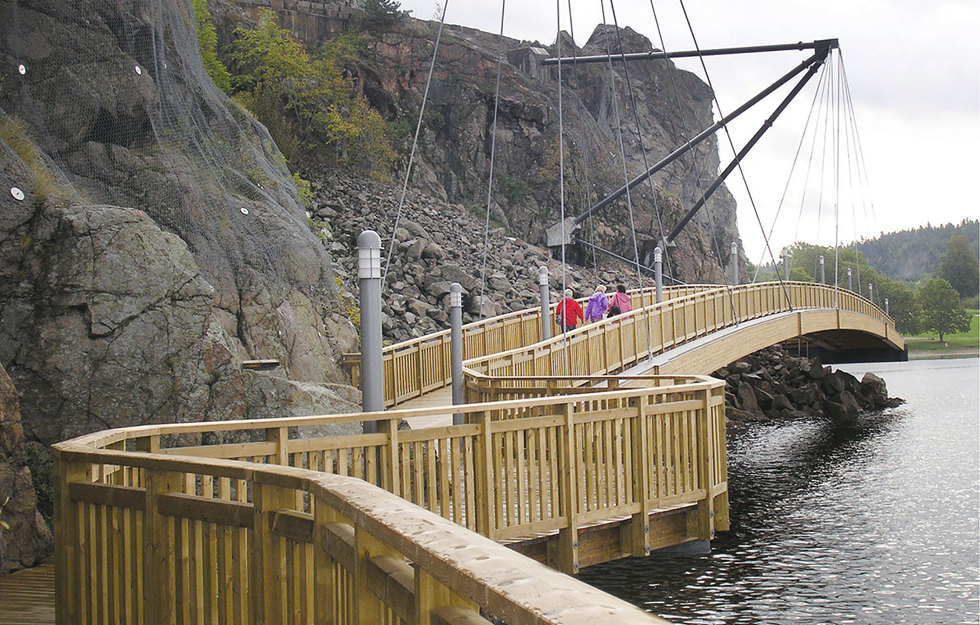
As long as a wood product remains in use, its carbon storage effect continues. This effect is often not included in a building’s LCA (life cycle analysis – a method for measuring overall environmental impact over the whole life cycle of the product), which is unfortunate.
An eternal ecocycle
When end-of-life wood products are used as biofuel or composted, the stored carbon dioxide is released. But in contrast to carbon emissions from fossil fuels, the incineration of wood does not add new quantities of carbon dioxide to the atmosphere. The released carbon dioxide is instead absorbed by newly planted and growing trees through photosynthesis. The circle is thus closed, and a new ecocycle can begin.
Minimal carbon footprint
So far, the main focus of the debate on buildings’ environmental impact has been on the usage phase, which is the time from completion of the building until it is demolished. But to gain a full picture of energy consumption, we should also look at the construction phase. Because even if we build zero energy buildings, the fact remains that the manufacture of the construction materials and the actual construction phase have a negative impact on the climate. It is therefore important for us to use construction materials and construction methods that have a minimal carbon footprint.
Modern construction methods using wood allow us to achieve just that: a minimal impact on the climate from buildings that also meet today’s demands for reduced energy consumption.
Wood is nature’s own solution to the climate issue. Next time you wonder how you are going to meet future demands for sustainability, think wood!
A four-storey wooden building stores 150 tonnes of carbon dioxide.
Research proves climate benefits for wood
A four-storey building in wood provides net storage of 150 tonnes of carbon dioxide, according to research by Mid Sweden University. This is because the wood stores the carbon dioxide absorbed by the growing trees. No other large-scale construction material has this capacity. (The analysis takes account of the energy consumed in manufacturing the wood, in transport and in the production of the building.)

Part of the solution to the climate issue is growing right here. Wood is both renewable and recyclable, and has a fantastic capacity to store carbon dioxide.
Building in wood has a long tradition in Sweden. And wood continues to represent tradition – but also eco-awareness and sustainability. There is no choice but to make planning and construction sustainable in the long term. Increased use of wood offers an opportunity to cut down on the use of finite raw materials and reduce carbon emissions from construction products.
A renewable material
The construction sector in Sweden emits carbon dioxide at an annual rate of 10 million tonnes. That is the same as all car traffic combined each year. Many commentators are now saying that we seriously need to review the way we build and the impact construction has on the climate. We need to see change.
And wood is going to be a vital resource in this change, with the material not yet reaching its full potential in the construction sector. We will be able to build more large buildings in wood in years to come.
The Kyoto Protocol’s international commitments to cut emissions of carbon dioxide are likely to lead to an increased use of wood in buildings. Many countries have launched national wood construction programmes as part of their strategy to replace more energy-intensive construction materials with wood. Interest and investment in wood construction techniques is growing all over the world – even in countries with little in the way of domestic forest raw material.
The key benefits of building in wood can be summarised in five points, the first four of which relate directly to the material and the fifth to the construction technique:
- Low energy consumption when extracting wood products for construction purposes from the forest, plus a large quantity of carbon neutral bioenergy stored in wood products. Carbon neutral means, in principle, that if the wood is incinerated in its end-of-life phase for bioenergy, the amount of carbon dioxide emitted at that point is equivalent to the amount originally absorbed by the tree. As such, there is no net addition of carbon dioxide to the atmosphere. The storage of carbon dioxide in the building (wood material) can be seen as a postponed neutralisation of the carbon dioxide stored.
- During the usage phase, a wood product stores carbon equating to around the same amount of atmospheric carbon dioxide as the wood product weighs.
- During demolition and removal, wood products can always be sent for energy recovery. This normally releases considerably more energy than is used to produce the building. This energy is carbon neutral and replaces fossil energy sources.
- In stark contrast to other construction materials, building in wood is based on a renewable natural resource and does not consume finite raw materials.
- Producing well-insulated apartment blocks with a wooden structural frame is resource-efficient, with reduced transport and rapid assembly. In addition, the construction site does not need to be as big and the noise levels are considerably lower, much to the relief of local neighbours.
Once wood can no longer be reused or its material recovered, for use in fibreboard and other sheet materials for example, it can still generate energy through incineration. This energy is climate-neutral and is in fact stored solar energy. The carbon dioxide released during incineration was once absorbed by the tree as it grew in the forest.
In 2008, the European Parliament approved a climate package, whose overall aim is to prevent global warming from increasing by more than two degrees, compared with pre-industrialisation. The EU has agreed four targets that must be met by 2020.
Based on the first three, these targets are often referred to as the 20-20-20 targets.
- Reducing greenhouse gas emissions by at least 20 percent compared with 1990 levels
- Moving towards a 20 percent increase in energy efficiency
- Increasing the share of renewable energy in final energy consumption to 20 percent
- A 10 percent share of renewables in the transport sector
We now need to gather all our strength and help each other within the industry to achieve these climate objectives. A great many initiatives have already been launched, but there is still a long way to go. Remember that your choices make a difference.



